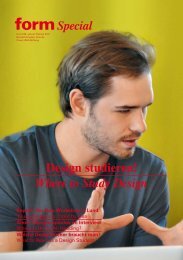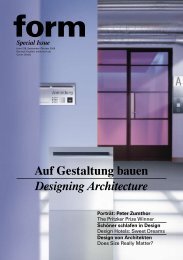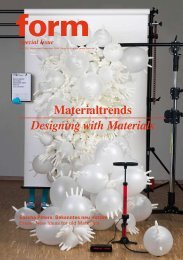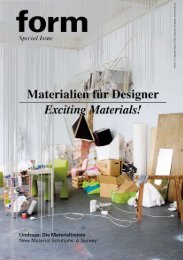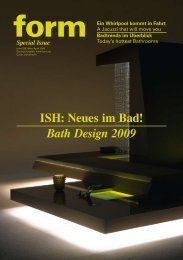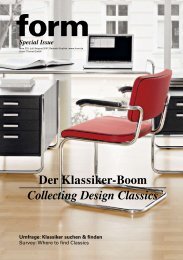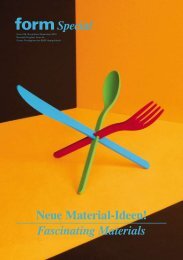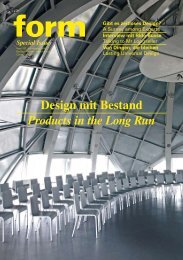Materialien für Designer The Magic of Materials - Creative Industries ...
Materialien für Designer The Magic of Materials - Creative Industries ...
Materialien für Designer The Magic of Materials - Creative Industries ...
Erfolgreiche ePaper selbst erstellen
Machen Sie aus Ihren PDF Publikationen ein blätterbares Flipbook mit unserer einzigartigen Google optimierten e-Paper Software.
Advertorial <strong>Materials</strong><br />
Suvarnabhumi Airport, Bangkok<br />
Natur material oder High-Tech, Ästhetik<br />
oder Funktion? Es geht beides zugleich –<br />
mit neuen, multifunktionalen <strong>Materialien</strong><br />
<strong>für</strong> Technik, Design und Architektur.<br />
Während Designprodukte wie Möbel und<br />
Bekleidun g nicht selten durch Stardesigner<br />
oder Trendmarken Kultcharakter erreichen,<br />
bleiben die da<strong>für</strong> eingesetzten <strong>Materialien</strong><br />
<strong>of</strong>t unbekannt – und das zu Unrecht.<br />
Denn die neue Generation innovativer<br />
Werkst<strong>of</strong>fe unterscheidet sich gravierend<br />
von ihren Vorgängern. Lautete noch vor<br />
wenigen Jahren das Zauberwort „Funktion“,<br />
geht der Trend jetzt zur „Multifunktion”.<br />
Wie aber werden zeitgemäße <strong>Materialien</strong><br />
unserem Lebensstil gerecht, der<br />
immer mehr von Mobilität und Flexibilität<br />
geprägt ist? Aufgrund von funktionsspezifischen<br />
Anpassungen verschwimmen<br />
die Grenzen zwischen Keramik, Gläsern,<br />
Metalle n und Kunstst<strong>of</strong>fen zusehends.<br />
Erscheinungsbil d und technische Eigenschaften<br />
können durch maßgeschneidertes<br />
Materialdesign beinahe unabhängig voneinande<br />
r kombiniert werden – etwa dank<br />
neuer Verbundmaterialien, Nanotechnologie,<br />
Photokatalyse und intelligenter<br />
Sensori k. So sind mit hochwertigen Schichtst<strong>of</strong>fen<br />
ähnliche Effekte – von hochglänzend<br />
bis seidenmatt – zu erzielen wie mit<br />
satinierten Gläsern. Und speziell behandelte<br />
Aluminiumbleche sind optisch nicht<br />
mehr von Edelstahl zu unterscheiden, aber<br />
man hinterlässt auf ihnen keine lästigen<br />
Fingerabdrücke mehr. Von besonderer Bedeutung<br />
sind dreidimensionale Strukturen:<br />
Metalle können geschäumt werden und<br />
bei leichtem Gewicht und einer homogenen<br />
18 <strong>Materials</strong><br />
Struktur beinahe beliebige Formen annehmen;<br />
Compounds und Sandwichkonstruktionen<br />
vereinigen sogar gegensätzlich scheinende<br />
Eigenschaften unterschiedlicher<br />
Ausgangsst<strong>of</strong>fe. Von besonderer Flexibilität<br />
sind innovative elastische Gel-<strong>Materialien</strong>:<br />
Halb flüssig, halb fest, passen sie sich etwa<br />
als Sitzpolster den Nutzern geschmeidig<br />
an – und zwar ganz ohne umweltschädliche<br />
Weichmacher. Dreidimensionale textile<br />
Abstandsgewirke sind flexibel und sorgen<br />
zusätzlich <strong>für</strong> gute Durchlüftung. Glasfasergewebe<br />
wird nicht nur als Bewehrung von<br />
Textilbeton eingesetzt. Und andere Textilie<br />
n sind sogar in der Lage durch Low-<br />
Emissivity-Beschichtungen den Energiebedarf<br />
großer Gebäude zu reduzieren<br />
oder dank einer <strong>of</strong>fenporigen Struktur<br />
die Raumakustik zu verbessern, wie beim<br />
Suvarnabhumi-Flughafen in Bangkok.<br />
Nebe n diesen synthetischen Materialkreationen<br />
gibt es auch einen starken Trend<br />
zu Naturwerkst<strong>of</strong>fen – vielleicht wird es<br />
soga r in absehbarer Zeit gelingen mit<br />
pflanzlicher Stärke eine breite Palette an<br />
Biokunstst<strong>of</strong>fen anzubieten, die uns unabhängig<br />
vom Erdöl macht. Eines aber ist<br />
klar: Die technische Erfindung ist immer<br />
nur Teil einer Innovation. Genauso wichtig<br />
ist ihre Anwendung zum richtigen Zeitpunkt<br />
– und hier sind wieder die <strong>Designer</strong> gefragt.<br />
Multifunctional materials. Natural materials<br />
or high-tech, aesthetics or functionality?–<br />
Innovativ e materials for technology, design<br />
and architecture. While it is not rare for design<br />
products such as furniture and clothing<br />
to attain cult status thanks to star designers<br />
or trendy brands, the materials used to produce<br />
them <strong>of</strong>ten go without mention – and<br />
wrongly so. For the new generation <strong>of</strong> innovative<br />
materials is markedly different from<br />
its predecessors. Whereas only a few years<br />
ago the magic word was still “function”, now<br />
the trend is moving in the direction <strong>of</strong> “multifunction”.<br />
Yet how can contemporary<br />
mate rials live up to our way <strong>of</strong> life, which is<br />
shaped to an ever increasing degree by mobility<br />
and flexibility? Owing to function-specific<br />
adjustments, the dividing lines between<br />
ceramics, glasses, metals and plastics are<br />
noticeably blurring. Appearance and technical<br />
properties can be combined almost independently<br />
<strong>of</strong> each other by means <strong>of</strong> customized<br />
material design, for example, thanks<br />
to new composite materials, nanotechnology,<br />
photocatalysis and intelligent sensory properties.<br />
Thus similar effects, from high gloss to<br />
silk matte, can be achieved with high-grade<br />
laminates as with satin-glazed glasses. And<br />
looking at them, we can no longer differentiate<br />
specially treated aluminum sheets from<br />
stainless steel, only you don’t get annoying<br />
fingerprints on them anymore. Three-dimensional<br />
structures are particularly important<br />
in this regard. Metals can be foamed and<br />
with a light weight and homogeneous structure<br />
can assume almost any form; compounds<br />
and sandwich constructions even<br />
combine the seemingly opposite properties<br />
<strong>of</strong> different source materials. Innovative<br />
elastic gel materials are particularly flexible:<br />
Semi-liquid, semi-solid, as seat cushions<br />
they mold themselves to the shape <strong>of</strong> the user<br />
– and that without using environmentallyharmful<br />
s<strong>of</strong>tening agents. Three-dimensional<br />
textile spacer fabrics are flexible and<br />
in addition ensure good air circulation.<br />
Fiber glass fabric is not only used to reinforce<br />
textile concrete. And other textiles are even<br />
able to reduce the energy consumption <strong>of</strong><br />
large buildings thanks to low-emission coatings<br />
or improve the acoustics <strong>of</strong> a room<br />
by means <strong>of</strong> an open-pore structure, as at<br />
Suvarnabhumi Airport in Bangkok. Alongside<br />
these synthetic material creations there<br />
is also a strong tendency towards the use<br />
<strong>of</strong> natural materials. Will we perhaps even<br />
succeed in the foreseeable future in producing<br />
a wide range <strong>of</strong> bioplastics using vegetable<br />
starch, finally putting an end to our dependence<br />
on crude oil? In any case, one thing<br />
is clear: Technical invention is always only<br />
one part <strong>of</strong> an innovation. Its application<br />
at the right time is just as important – and<br />
this is where designers come in once again.



![[pdf - 2.18 MB] Sonderheft zur ISH - Form](https://img.yumpu.com/11048003/1/184x260/pdf-218-mb-sonderheft-zur-ish-form.jpg?quality=85)
